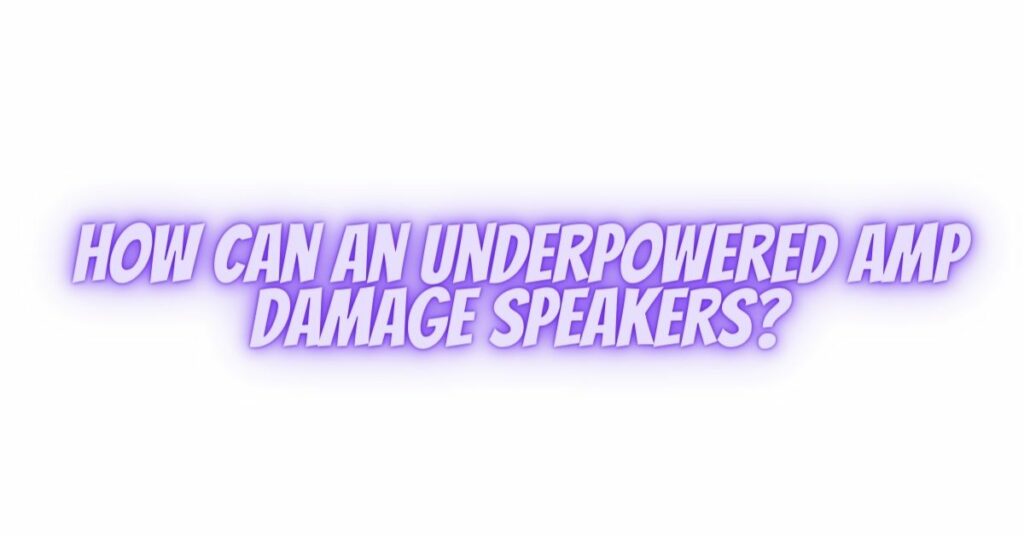The combination of an amplifier and speakers in an audio system is a fundamental partnership, where each component plays a critical role in delivering sound. While it’s common to think about the potential damage caused by overpowering an amplifier, the question of how an underpowered amplifier can damage speakers is also important to understand. In this comprehensive article, we will explore the mechanisms and scenarios in which an underpowered amp can harm your speakers.
Understanding Underpowered Amplifiers
An underpowered amplifier is one that cannot deliver sufficient power to the connected speakers, leaving them without the necessary energy to produce sound at the desired volume or quality. It’s important to remember that an underpowered amplifier is not inherently dangerous, but it can lead to problems when pushed to its limits.
- Overexcursion and Distortion
One of the key ways an underpowered amplifier can damage speakers is by causing overexcursion of the speaker cones. Overexcursion happens when the amplifier’s insufficient power causes the speaker’s diaphragm (cone) to move excessively to reproduce low-frequency sounds. This results in several issues:
- Excessive Cone Movement: The diaphragm may move beyond its designed limits, causing it to bottom out or hit the interior components of the speaker. This can lead to physical damage to the speaker.
- Distortion: To compensate for the lack of power, the speaker may produce distorted sound as it struggles to reproduce low-frequency signals. Distortion not only degrades sound quality but can also damage speakers over time.
- Thermal Overload
Another way an underpowered amplifier can harm speakers is through thermal overload. When an amplifier lacks sufficient power to drive the speakers, it can cause the following issues:
- Overheating: To achieve the desired volume, the amplifier may operate at or near its maximum power output for extended periods. This generates excess heat that can potentially damage the amplifier or, in extreme cases, lead to overheating of the voice coils in the speakers.
- Voice Coil Damage: When the voice coil in a speaker heats up excessively, it can deform or even melt the adhesive that holds the coil’s windings together. This can lead to a loss of functionality and impaired speaker performance.
- Clipping and Harmonic Distortion
Clipping is a common issue that arises when an underpowered amplifier is pushed to deliver more power than it can provide. Clipping occurs when the amplifier attempts to reproduce an audio signal with greater amplitude than its maximum capabilities. The result is a squared-off waveform that contains harmonic distortion, which can lead to:
- Excessive Excursion: As the clipped signal is sent to the speaker, it may cause the diaphragm to move excessively, leading to overexcursion and potential damage.
- Overheating: The continuous production of distorted, clipped signals can lead to speaker overheating, which, as mentioned earlier, can be damaging.
Preventing Damage
To prevent damage to speakers from an underpowered amplifier, consider the following measures:
- Use speakers with a higher sensitivity rating, which require less power to produce the same volume.
- Operate the system at moderate volumes to avoid pushing the amplifier to its limits.
- Address the power mismatch by upgrading to an amplifier that matches the power handling of your speakers.
- Consider adding a subwoofer to relieve the main speakers from the demand of producing low-frequency content, which can strain an underpowered amplifier.
Conclusion
An underpowered amplifier can potentially damage speakers through overexcursion, thermal overload, clipping, and harmonic distortion. While it’s not an immediate threat in all cases, continuous use of an underpowered amp can lead to degradation in sound quality, potential damage, and reduced speaker lifespan. To ensure the longevity of your speakers and maintain audio quality, it’s advisable to address the power mismatch by upgrading to an amplifier that better matches the power handling of your speakers.


